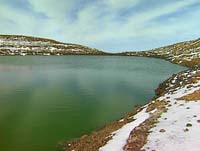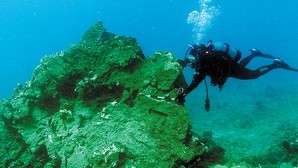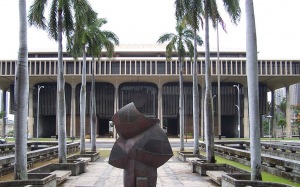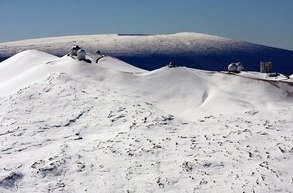Blog
News, updates, finds, stories, and tidbits from staff and community members at KAHEA. Got something to share? Email us at: kahea-alliance@hawaii.rr.com.
Insanity Reigns at Hawaii's State Capitol
From Marti:
The Hawaii Legislature is seriously considering a raid on our most important conservation funds in order to balance the state budget. This is insane given all that these few millions do to protect the quality of our drinking water, the health of our native ecosystems, and truly local jobs. But, the insanity goes a step further once you realize they are considering these massive cuts when the state is owed millions upon millions for the use of public land on Mauna Kea.
For 40 years foreign-owned telescopes have used (and destroyed) acres of public land on the summit of Mauna Kea without paying any rent. Rent, that is required by state law! It’s estimated that the state could earn at least $50 million a year just by charging market-based rent for the use of our public lands, instead of giving it away to foreign corporations and countries… and cutting important programs and jobs to make ends meet.
On Sunday, the Honolulu Advertiser published the editorial below from some of the entities that directly benefit from these important programs. If you would like to express your support for these programs to the Hawaii Legislature, click here.
Natural resources permit our survival
By Herbert “Monty” Richards, Gary and Kukui Maunakea-Forth and Rick Barboza
Honolulu Advertiser, April 12, 2009
We thank The Advertiser for its editorial (April 2) on the necessity of natural resource stewardship even during fiscal crises. Generations of ranchers, farmers and land managers have always understood the close connection between a healthy natural environment, land protection, stewardship, water supply, agricultural self-sufficiency and the economy.
Business and government often measure our economy by the number of tourism and construction jobs in operation. That’s understandable, but doesn’t account for vast natural assets (water, forests, beaches, coral reefs, agricultural land) that support every person in Hawai’i — residents and visitors — who depend on services from the environment for their livelihoods, health and welfare.
The programs that are funded by the DLNR’s Natural Area Reserve Fund and the Land Conservation Fund are essential to the protection of our Hawaiian resources. They support watershed management, invasive species control, agricultural production, forestry, coastal protection and cultural preservation. Hundreds are employed and more than 1 million acres are managed, protected and cultivated for public benefit. These healthy, managed natural resources and the services they provide allow us the lifestyle we all enjoy and permit our survival in the middle of the vast Pacific.
Due to difficult times, conveyance tax revenue that supports these funds is down 50 percent. These programs will be cut by half or more even without House Bill 1741. Further reduction in the NAR Fund and Land Conservation Fund as proposed in HB 1741 would either eliminate many of these essential programs or cripple them to the point of leaving them inoperable and nonfunctioning. These programs leverage funding by at least 1:1, and in some cases as much as 1:3, with federal, county and private dollars (i.e., for every state dollar spent, three additional matching non-state dollars can be leveraged).
The NAR Fund and the Land Conservation Fund are our state’s way of supporting large-scale conservation that protects our incredible natural resources, supports sustainable land and water management, ensures high-quality jobs, and guarantees the perpetuation of essential ecosystem services worth billions of dollars. Without watershed management, critical drinking water resources will dry up or become contaminated.
Without personnel in the field controlling invasive species, pests like bee mites will infiltrate our shores — wiping out industries like our local honey/beekeeping industry, or requiring tens of millions to control and eradicate (e.g., miconia, coqui frogs). Without land protection, more agricultural, watershed, forest, coastal and culturally important lands will be converted; reducing our ability to feed ourselves and attract visitors who appreciate Hawai’i's natural beauty.
Without these programs, successes like MA’O Organic Farms might not be possible. MA’O recently purchased agricultural land using Land Conservation Funds, allowing it to expand its organic farm, and employ over two dozen high school graduates from Wai’anae and Nanakuli and pay their college tuition and stipends. As fifth-generation ranchers in North Kohala, Kahua Ranch and its neighbors in the Kohala Watershed Partnership are using their resources and support from the NAR Fund to control invasive species and protect 65,000 acres of native forests and watersheds.
With help from the NAR Fund’s Forest Stewardship Program, Hui Ku Maoli Ola will restore over 30 acres of land in Ha’iku valley. Keeping the NAR Fund percentage at 25 percent and the Land Conservation Fund percentage at 10 percent is a small investment for such large, sustainable and long-term benefits for our island communities.
Herbert “Monty” Richards of Kahua Ranch, Gary and Kukui Maunakea-Forth of MA’O Organic Farms and Rick Barboza of Hui Ku Maoli Ola wrote this commentary for The Advertiser.
April's Action Alert Line-Up
| Email not displaying correctly? View it in your browser. |
 |
| Aloha mai Kakou! Spring is here, which means the rains will be coming to an end soon and so will the 2009 Legislative Session. In these last heated weeks of the session, the public will get one last chance to be heard on the proposals affecting our environment and culture. At the same time, it is important not to ignore key decisions affecting our public trust resources that are being made outside the Capitol. To help you keep track of it all, here are four pressing issues to take action on right now and help protect the things we all love about Hawaii nei. 1. Defend the NAR Fund… because Conservation Can’t Wait!
On Monday, the State Ways & Means Committee will consider a measure to take money away from the Natural Area Reserve Fund in order to balance the state budget. For the last ten years, this fund has provided for the conservation programs that have successfully protected our native forests, supported important watersheds, and controlled invasive species – not to mention provide affordable housing and encourage local agriculture. Cutting this fund now will short-change our children by denying them the benefit of clean water, climate change control, and healthy native ecosystems. Plus, we all know it is simply unnecessary because the state could generate at least $50 million a year from the foreign telescopes that currently use state land on Mauna Kea for free! If the state just renegotiated those leases to be fair (and legal), then Hawaii could weather this economic crisis without cutting programs (or jobs). Take action now! Tell Hawaii’s Senators: Don’t Raid, Make the Telescopes Pay. This is it. All of the hardwork to protect Mauna Kea from the pressure to build ever-larger telescopes will culminate in two hearings this week: – On Monday, in Honolulu, the State Ways & Means Committee will decide whether to pass HB 1174 to transfer authority for Mauna Kea to the University. – On Thursday, in Hilo, the State Board of Land and Natural Resources will decide whether to adopt the University’s latest development plan for the summit. Though the University continues to claim it now can properly manage the summit, the details of their plan reveal this is just the same old scam to consolidate its control over the public’s sacred summit. The University’s latest’s scheme does nothing to protect Mauna Kea’s unique and endangered alpine habitat, uphold continued cultural and religious practices on this sacred summit, or control telescope development. Add your voice to the thousands who have already spoken up in support of genuine protections for the sacred summit of Mauna Kea – just click here. Attend the Public Hearing in Hilo on April 8th and 9th at the Hilo Hawaiian Hotel (71 Banyan Drive, 96720) at 9:00 am in the Moku Ola Ballroom. 3. Industrial Aquaculture Invades the Kohala Coast Huge, untethered, self-powered, underwater spheres crammed with thousands of fish floating off our coast. Yikes! Sounds like a science fiction B-film, but this is exactly what is being proposed for the Kohala coast of Hawaii Island. Hawaiian Oceanic Technology, Inc. is applying for a permit to create a new massive tuna ocean fish farm. They want to use 247 acres of our ocean to house 12 orb-like cages so they can grow tuna and export it out of Hawaii. Their draft EIS does not answer the basic questions everyone is asking: - How much waste will be created and how will it affect the marine environment? Our ocean is a public trust resource and the public deserves to know what is going to happen to it before this project causes any harm. Click here to ask Hawaiian Oceanic Technology and the approving agencies to address the public’s concerns and questions before using our waters for a project that could hurt our ocean and the wildlife in it. 4. Uphold Your Right to Go Beach – Support the Public Access Rights Bill Even though the public’s right to access the shoreline is protected by law, the lack of enforcement has created a de facto barrier on public beach access. S.B. 1088 is a simple bill that would help improve enforcement of beach access… if only it could get a hearing in the House Judiciary Committee. Click here to urge Rep. Karamatsu to hear S.B 1088 regarding public access. If you have a few minutes, give Rep. Karamatsu a polite phone call at 808-586-8490. Mahalo Pumehana, www.kahea.org |

Sacred Lake Waiau in the Natural Area Reserve at the summit of Mauna Kea. KAHEA: the Hawaiian-Environmental Alliance is a network of thousands of diverse individuals islands-wide and around the world. Together, we work to secure the strongest possible protections for Hawaii’s most ecologically unique and culturally sacred places and resources. Mailing Address: KAHEA is funded grassroots-style, and does not receive any Federal or corporate money. It is the financial support of many INDIVIDUALS, all giving what they can, that keeps the lights on and the campaigns going here at KAHEA. |
|
|
|
Holding the Navy Accountable on Two Fronts
From Marti:
The Navy has been on the hot seat lately for the damage it has caused in Hawaii nei. In central and western Oahu, the Environmental Protection Agency and the state got a commitment from the Navy to clean up any remaining contamination at two Superfund sites – one in Lualualei near the naval munitions storage area and the other in Wahiawa. While preliminary investigations have indicated that no immediate threats currently exist at the sites, soil contaminants at the sites include PCBs, volatile organics, semi-volatile organics and metals. PCBs can cause cancer in animals and adversely affect the nervous, immune, and endocrine systems in humans.
“Our agreement with the Navy and the state finalizes the process that the Navy will follow to complete the investigation and clean up of any remaining chemical contamination at both sites.” said Keith Takata, director for the EPA Pacific Southwest Region’s Superfund Division.
The agreement with the Navy is open to public comment. Get your say in now by visiting: www.epa.gov/region09/NavalComputer
Check out the full article at The Hawaii Independent: http://www.thehawaiiindependent.com/hawaii/oahu/2009/04/02/epa-us-navy-agrees-to-clean-wahiawa-lualualei-superfund-sites/
 And, on the South shore of Oahu, controversy is brewing as the state attempts to hold the Navy financially responsible for the carnage of coral from the USS Port Royal grounding in February 2009. Ten acres of ancient coral was destroyed! Chunks as large as cars are still bouncing around on the ocean floor causing further damage.
And, on the South shore of Oahu, controversy is brewing as the state attempts to hold the Navy financially responsible for the carnage of coral from the USS Port Royal grounding in February 2009. Ten acres of ancient coral was destroyed! Chunks as large as cars are still bouncing around on the ocean floor causing further damage.
“There is a critical need for the U.S. Navy to mitigate the damage which has occurred, which continues to occur, and which will get worse with the upcoming south summer swell,” said Laura H. Thielen, chairwoman of the DLNR, in the letter.
“We urge the U.S. Navy to commit appropriate resources to rescue disturbed or destroyed coral, remove or stabilize rubble, and protect loose live coral that has resulted from this incident.”
Here, here!! Systems that ensure the “polluter pays” are a completely reasonable (and actually quite capitalist) approach to addressing damage to our environment. The Navy’s negligence destroyed a significant part of our ocean environment. They should be required to pay for the injury they have caused and do all they can to prevent further damage.
What the Navy does in this situation will be a key indication of what the public can expect from their activities affecting the Papahanaumokuakaea Marine National Monument in the Northwestern Hawaiian Islands (you will recall the Navy plans to intercept chemical-laden missiles over Nihoa – the only home of at least four endangered species and one of the most significant cultural and archeological sites in the archipelago).
Check out the full article here: http://www.honoluluadvertiser.com/article/20090402/NEWS11/904020369/1001
Superferry by any other name...
Write up from Joan Conrow on the Hawaii Supreme Court Superferry decision, which found Act 2 exempting the Hawaii Superferry from EIS law to be unconstitutional: http://kauaieclectic.blogspot.com/2009/03/musings-supreme-court-slap-down.html
My inbox, meanwhile, has been popping with jubilant messages about the ruling, but folks aren’t happy just because they won. They also see it as a vindication of the rule of law and the belief that laws are supposed to apply equally to everyone. You don’t just go in and have a new one written when a court decision comes down that you don’t like.
Red-Rover, Red-Rover, Cross on Over

Today is Cross-Over Day at the State Capitol, the half-way point in the legislative process… and the day the overwhelming majority of bills are declared officially dead (until they can be resurrected next session). Here is a run-down of the bills KAHEA is following that are still alive this session. Click on the bill numbers to get the latest update on their status.
GOOD BILLS
SB 1088 - Improves enforcement of the public’s right to beach and mauka access by creating a citizen suit provision. Call Rep. Sharon Har at 808-586-8500 to ask that it be heard before the House Water, Land, and Ocean Committee.
HB 1663/SB 709 - Bans the genetic modification of taro in Hawaii. (Watch these ones closely. Like last year, amendments could turn them against the interests of Haloa, taro farmers, and taro consumers).
SB 701 – Establishes a moratorium on the siting of landfills along the Leeward Coast. This is an important bill to help protect the public health of Waianae Coast residents, unfortunately it has a lot of hearings to get through. Call Rep. Rita Cabanilla at 808-586-6080 to express your support.
SB 86 – Establishes the Makua Valley Reserve Commission to allow for community involvement in the management of Makua Valley. This bill also has a lot of hoops to get through. Call Rep. Ito at 808-586-8470 to advocate for its first hearing.
SB 1199 – Designates certain state waters surrounding the island of Molokai as the Molokai Community-Based Subsistence Fishing Area. Protecting the health of the shoreline is critical to Molokai’s economy welfare, unfortunately commercial fishers and aquarium collectors want to continue to take from these coffers. Call Rep. Calvin Say at 808-586-6100 to ensure this bill gets referred to the Water, Land, and Ocean Committee.
BAD BILLS
HB 1174 - Transfers management of the sacred summit of Mauna Kea to the lease-holder/developer, the University of Hawaii. Public opposition successfully defeated three similar bills earlier this session. Call Sen. Jill Tokuda at 808-587-7215 to urge this bill not be heard. Check out our previous posts to learn way this bill is the best way to undermine protections for Mauna Kea.
HB 1226 – Allows federal preemption of all state and local regulations on genetic modification (except taro). Labelled the Worst Idea of 2009… hopefully it won’t go any farther.
SB 1108 – Extends the effective date of the Aha Kiole Advisory Committee. Having a community-based system for managing our fragile resources is exactly what Hawaii needs, but without adding any additional safeguards to this existing system means it could be misused again the way WESPAC did last year.
HB 640 – Exempts certain developments affecting public rights-of-way (like trails) from completing an environmental impact statement. This totally undermines one of the few opportunities for public oversight of construction in Hawaii. Call Sen. Mike Gabbard at 808-586-6830 to ask it not be heard in the Environment Committee.
SB 1311 – Exempts the University’s Institute of Marine Biology from all permitting requirements for all activities in Kaneohe Bay. Our nearshore waters are our most valuable resource and the research being conducted in them should meet the highest standards of the precautionary principle to ensure that no harm comes to them. Help stop this bill by calling Rep. Calvin Say at 808-586-6100 to ask that it not be heard in the House.
HB 1741 – Raids the Natural Area Reserve System fund to make up for part of the budget shortfall. While the money in this fund is crucial to protecting Hawaii from invasive species, there isn’t nearly enough to make a dent in the budget shortfall. Instead, the state should make the foreign telescope owners on Mauna Kea pay rent for use of state lands… like the law requires.
HB 1712 – This is the same “Right to Fish” bill from years passed that paralyzes the DLNR from taking any management actions to protect Hawaii’s marine resources. If we are really interested in protecting our environment, then the goal should be to give DLNR more tools, not less, to do the job and be held accountable.
Mark your calendars: the next major deadline for these bills is April 9th.
If you want to stay involved, you can sign up for KAHEA’s action alert network by clicking here. You can also get hearing notices on any bill you are concerned about by clicking here. On Oahu, some hearings are aired live on “Capitol TV,” Olelo channel 53.
How to Biofuel?
Check out Andrew Alan McNarie’s excellent piece on the present (and possible future) of biofuels in Hawaii in the Hawaii Independent.
In 2002, the state Legislature enacted provisions in Hawai‘i Revised Statutes, Section 171-95, to allow the Board of Land and Natural Resources to directly negotiate leases of state land to the companies producing vegetation-derived “biofuels.”
HRS 171-95 is bearing fruit (and trees, and bushes). Efforts are underway to produce biodiesel and biofuel-generated electricity on Maui, O‘ahu and Kaua‘i. At least six different companies are interested in producing biofuel on the Island of Hawai‘i.
But there have been setbacks. After a bruising series of public meetings on the Big Island, one biofuel firm has repudiated its own “Agreement in Principle” to lease state land, and legislators are reconsidering the BLNR’s authority to negotiate such agreements.
See the full article at: http://www.thehawaiiindependent.com/hawaii/2009/02/04/the-bio-fuel-land-rush-part-i-blnr-bobbles-biofuel-agreements/
Bad Mauna Kea Bills Move Through Legislature

From Rob Perez’s excellent coverage of the Mauna Kea bills currently moving through the state legislature:
Two bills (HB 1174 and SB 502) giving UH authority over the 11,000-plus acres of ceded lands it leases from the Department of Land and Natural Resources have been approved by two committees each in the House and Senate, worrying environmentalists, Native Hawaiian groups and others.
The bills permit UH to regulate public and commercial uses of the land, and critics believe that authority would be broadly applied. Lawmakers call the legislation a “work in progress.”
“This is a very, very bad idea,” said Marti Townsend, program director of KAHEA: The Hawaiian-Environmental Alliance.
Critics say transferring such oversight to UH would be a huge mistake in light of the school’s poor track record on Mauna Kea and the dangerous precedent the action would set, essentially turning over responsibility for the land to its leaseholder or developer.
See full article at: http://www.honoluluadvertiser.com/article/20090222/NEWS03/902220351/1001






